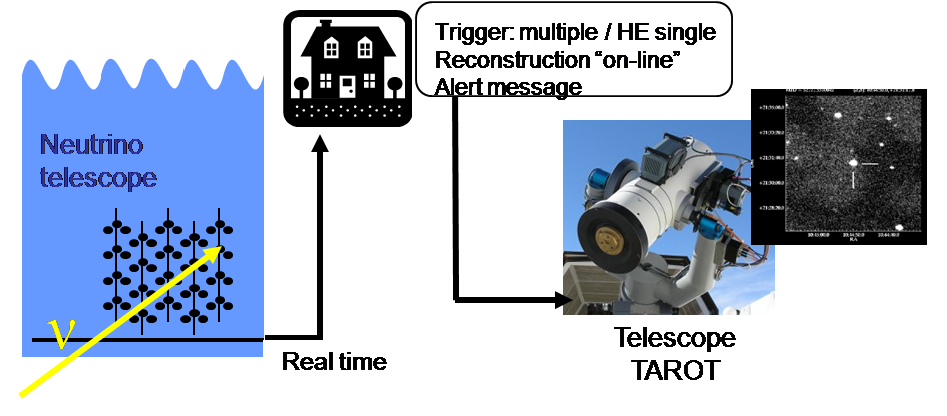|
Introduction
To detect transient sources, two different methods can be used. The first is based on the search for neutrino candidates in conjunction with an accurate timing and positional information provided by an
external trigger: the triggered search. The second is based on the search for "special neutrino events" coming from the same location within a given time window: the rolling search. The purpose of this
project is the implementation of the rolling method in the ANTARES experiment in collaboration with an optical telescope network.
Two different neutrino alert strategies have been implemented in ANTARES: the detection of neutrino doublets and the detection of single high energy neutrino. The detection of a neutrino doublet is
almost statistically significant. Indeed, the number of doublet due to atmospheric neutrinos is of the order of 0.05 per year within a temporal window of 900 s and a directional cone of 3° x 3° are
defined. For the search for a single high energy neutrino event, the reconstructed muon energy is required to be higher than a given energy threshold (typically above few TeV), in addition a most
restrictive quality cut on the muon track reconstruction is applied.
In contrast to the current gamma-ray observatories, a neutrino telescope covers at least a half hemisphere if only up-going events are analyzed and even 4p sr if down-going events are considered.
Moreover, this method requires no hypothesis on the period during which the neutrinos are emitted with respect to the optical flash, a parameter not well constrained by the various theoretical
models. More importantly no assumption is made on the nature of the source and the internal acceleration mechanisms occurring inside. This approach is therefore efficient for all types of transient
sources: GRB, SN, µquasars, flare of AGN, etc.
Description of the project:
The ANTARES Collaboration has implemented an on-line event reconstruction (named BBfit). This analysis strategy contains a very efficient trigger based on
local clusters of photomultiplier hits and a simple event reconstruction. The two main advantages are a very fast analysis (between 5 and 10 ms per event)
and a quite good angular resolution (~0.8°). The minimal condition for an event to be reconstructed is a minimum of six storeys triggered on at least
two lines. To select a high purity sample of up-going neutrino candidates, a quality cut is applied to the result of the chi2 minimisation of the
muon track reconstruction based on the measured time and amplitude of the hits associated with the track. In order to obtain a fast response, the
on-line reconstruction does not use the dynamical reconstructed geometry of the detector lines.

Two programs have been implemented by the ANTARES Collaboration in order to create the neutrino alert and send it to the telescopes. The BBalert program is an application which includes the on-line
reconstruction (BBfit), the "special neutrino events" selection and the creation of the alert message in the GCN format. A quality criterion, coded between 1 and 4, is attributed to each alert (4 correspond
to the best quality events and 1 to the worst ones). This criterion is computed from the quality criterion of the reconstruction, the number of lines and the energy estimators. This program is connected to
the ANTARES data stream after the data filters (used for the trigger) before writing the data to disk. The "TAToO run control" is a stand-alone QT control application which channels the alerts generated by
BBalert to the telescope servers. The main functions are:
- Control the BBalert application (run, stop and monitor)
- Subscribe and monitor ligier i.e. the link between BBalert and the ANTARES run control (ligier)
- Wait for new alerts
- Connects and monitor the connections to the different TAROT servers
- Filter the alerts (time, trigger rate)
- Log all events and alerts
- Send e-mail and SMS after each alert
The follow-up of the ANTARES alerts is done by two networks of robotic telescopes: TAROT and ROTSE.
The TAROT (Télescope à Action Rapide pour les Objets Transitoires / Rapid Action Telescope for Transient Objects) network comprises two 25cm optical telescopes located at Calern (South of France)
and La Silla (Chile). The ROTSE network comprises four 45cm optical telescopes located in US, in Turkey, in Namibia and in Australia. The main advantages of these instruments are the large field of
view of ~1.9° x ~1.9° and their very fast positioning time (less than 10s). These telescopes are well suited for such a program.
The coordinates of the TAROT and ROTSE telescopes are:.
- TAROT La Silla (Chile): -29 15 N -70 43 E
- TAROT Calern (France): 43 43 N 6 54 E
- ROSTE 3a Coonabarabran Naomi (Australia): -31 16 N 149 4 E
- ROSTE 3b Fort Davis (Texas, USA): 30 36 N -103 54 E
- ROSTE 3c Windhoek (Namibia): -22 36 N 17 6 E
- ROSTE 3d Antalya (Turkey): 36 54 N 30 42 E
In order to increase the chance to observe an optical counter part of the ANTARES alert, we have adopted the following observation strategy with the optical telescopes:
- One real time acquisition (at T0): 6 images of 3 minutes for TAROT and 30 images of 1 minute with ROTSE telescopes. The real time treatment of the alert will depend on the availability of
the telescope; it may be delayed by few minutes.
- Acquisitions delayed (at T0 +): 6 images of 3 minutes at T0+1 day, T0+2 days, T0+3 days, T0+4 days, T0+5 days, T0+6 days, T0+7 days, T0+9 days, T0+15 days, T0+27 days for TAROT (8 images of
30 seconds for ROTSE the same days more T0+16 and T0+28days). These steps are just indicative and depend on the availability of the telescope: it can be delayed or advanced in order to fit in the
observation program or to have the possible source at the optimal position in the sky.
For more details on the experiments:
| |
|

